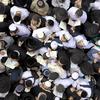1: Video, the Jewish Daily Forward's “Next Year in Uman: A Journey to Ukraine” (2011).
At the time of Reb Nakhman’s death, over two hundred years ago, he asked that his Hasidim (devotees) make an annual pilgrimage at Rosh Hashanah to his grave in Uman, Ukraine. Since the end of the Cold War in the 1990s, this pilgrimage has become one of the leading events in the world of Orthodox Jewry. In recent years, upwards of 20,000 Jewish men and boys—women are almost completely excluded from the event—travel primarily from Israel and the United States for three days of prayer and celebration of both the Jewish New Year and Reb Nakhman’s teachings.
The pilgrimage to Uman is the defining event of Breslover Hasidism today. Although the activities that take place there are dedicated to traditional religious rituals, they are filtered through the charisma associated with Reb Nakhman himself. Reb Nakhman died in 1810, and unlike other Hasidic leaders he never chose a successor to lead his movement—thereby earning for his followers the Yiddish epithet toyte khsidim (“dead Hasidim,” since they follow a dead rebbe)—but the movement holds together thanks to the devotion Reb Nakhman inspires and the meaning his Hasidim project onto him. The stories he left behind, which were first published five years after his death, contribute to this sense of connection, as if he were telling them to his followers today.
Published in 2011 by the English-language edition of the Yiddish newspaper The Forward, this video is a slideshow put together by an American Jewish photographer from his photos of various Uman pilgrimages in the early 2000s.
Those who would like to see footage of the event may wish to view this short video of the 2016 Uman pilgrimage, published by news outlet Ukraine Today.
Suggested Activity: Discuss the ways in which “The Loss of the Princess” contributes to Reb Nakhman’s mystique, by creating an aura of mystery and creativity for the rebbe quite distinct from the functions of an ordinary rabbi. Once students have seen one or both videos, ask: how does the twenty-first century pilgrimage add new dimensions to this mystique? Consider how Reb Nakhman’s appeal has grown beyond the parameters of his own Hasidim, or even Hasidism as such. How might stories like this have helped lead to such wide appeal?
As seen in these images (and videos), contemporary Hasidim have added elements of dance, music, and contemporary fashions to the celebration of Reb Nakhman’s memory. Is this different from what you would expect to see on a religious pilgrimage memorializing a dead spiritual leader? If so, how? Thinking about “The Loss of the Princess,” how is it different from (or similar to) literature you are familiar with that is considered “religious”?
Consider the fact that Reb Nakhman begins his story announcing that he conceived it on a journey, and that the story itself would bring all of its hearers (or readers) to repentance. What role do travel, journeying, quest, and repentance play in the story? How might that connect with the contemporary Uman pilgrimage?
Sources: Forward, “Next Year in Uman: A Journey to Ukraine,” Apr. 28 2011, video, 6:32, https://www.youtube.com/watch?v=gjuB-DaOF_s&feature=emb_logo.

